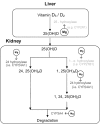Magnesium status and supplementation influence vitamin D status and metabolism: results from a randomized trial
- PMID: 30541089
- PMCID: PMC6693398
- DOI: 10.1093/ajcn/nqy274
Magnesium status and supplementation influence vitamin D status and metabolism: results from a randomized trial
Abstract
Background: Previous in vitro and in vivo studies indicate that enzymes that synthesize and metabolize vitamin D are magnesium dependent. Recent observational studies found that magnesium intake significantly interacted with vitamin D in relation to vitamin D status and risk of mortality. According to NHANES, 79% of US adults do not meet their Recommended Dietary Allowance of magnesium.
Objectives: The aim of this study was to test the hypothesis that magnesium supplementation differentially affects vitamin D metabolism dependent on baseline 25-hydroxyvitamin D [25(OH)D] concentration.
Methods: The study included 180 participants aged 40-85 y and is a National Cancer Institute independently funded ancillary study, nested within the Personalized Prevention of Colorectal Cancer Trial (PPCCT), which enrolled 250 participants. The PPCCT is a double-blind 2 × 2 factorial randomized controlled trial conducted in the Vanderbilt University Medical Center. Doses for both magnesium and placebo were customized based on baseline dietary intakes. Subjects were randomly assigned to treatments using a permuted-block randomization algorithm. Changes in plasma 25-hydroxyvitamin D3 [25(OH)D3], 25-hydroxyvitamin D2 [25(OH)D2], 1,25-dihydroxyvitamin D3, 1,25-dihydroxyvitamin D2, and 24,25-dihydroxyvitamin D3 [24,25(OH)2D3] were measured by liquid chromatography-mass spectrometry.
Results: The relations between magnesium treatment and plasma concentrations of 25(OH)D3, 25(OH)D2, and 24,25(OH)2D3 were significantly different dependent on the baseline concentrations of 25(OH)D, and significant interactions persisted after Bonferroni corrections. Magnesium supplementation increased the 25(OH)D3 concentration when baseline 25(OH)D concentrations were close to 30 ng/mL, but decreased it when baseline 25(OH)D was higher (from ∼30 to 50 ng/mL). Magnesium treatment significantly affected 24,25(OH)2D3 concentration when baseline 25(OH)D concentration was 50 ng/mL but not 30 ng/mL. On the other hand, magnesium treatment increased 25(OH)D2 as baseline 25(OH)D increased.
Conclusion: Our findings suggest that optimal magnesium status may be important for optimizing 25(OH)D status. This trial was registered at clinicaltrials.gov as NCT03265483.
Figures



Comment in
-
Personalized magnesium intervention to improve vitamin D metabolism: applying a systems approach for precision nutrition in large randomized trials of diverse populations.Am J Clin Nutr. 2018 Dec 1;108(6):1159-1161. doi: 10.1093/ajcn/nqy294. Am J Clin Nutr. 2018. PMID: 30541094 Free PMC article. No abstract available.
References
-
- Moyer VA. Vitamin D and calcium supplementation to prevent fractures in adults: US Preventive Services Task Force recommendation statement. Ann Intern Med. 2013;158:691–6. - PubMed
-
- Cianferotti L, Bertoldo F, Bischoff-Ferrari HA, Bruyere O, Cooper C, Cutolo M, Kanis JA, Kaufman JM, Reginster JY, Rizzoli R et al. .. Vitamin D supplementation in the prevention and management of major chronic diseases not related to mineral homeostasis in adults: research for evidence and a scientific statement from the European Society for Clinical and Economic Aspects of Osteoporosis and Osteoarthritis (ESCEO). Endocrine. 2017;56(2):245–61. - PMC - PubMed
-
- Wactawski-Wende J, Kotchen JM, Anderson GL, Assaf AR, Brunner RL, O'Sullivan MJ, Margolis KL, Ockene JK, Phillips L, Pottern L et al. .. Calcium plus vitamin D supplementation and the risk of colorectal cancer. N Engl J Med. 2006;354:684–96. - PubMed
-
- Lappe JM, Travers-Gustafson D, Davies KM, Recker RR, Heaney RP. Vitamin D and calcium supplementation reduces cancer risk: results of a randomized trial. Am J Clin Nutr. 2007;85:1586–91. - PubMed
Publication types
MeSH terms
Substances
Associated data
Grants and funding
LinkOut - more resources
Full Text Sources
Medical
Molecular Biology Databases

